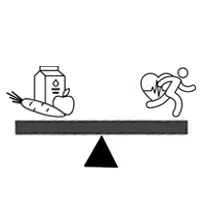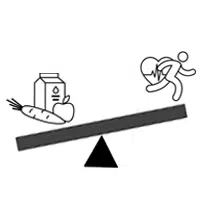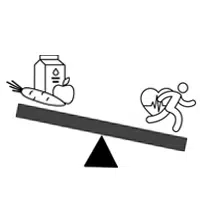Show summary Hide summary

Energy balance is an essential concept for understanding body weight management and health in general. The energy balance represents the balance between the amount of energy we expend and the amount we put into our bodies through food and drinks. Avoiding an energy imbalance is essential for maintaining a stable and healthy body weight.
Energy output
Energy expenditure refers to the amount of energy our body uses on a daily basis. It meets two main needs:
1. Resting Energy Expenditure (REE) or Basal Metabolic Rate (BMR)
The basal metabolic rate represents the energy required to maintain the body’s basic functions at rest, such as breathing, blood circulation and body temperature regulation. It accounts for 60-70% of total energy expenditure and is influenced by factors such as height, weight, age, sex and genetics, as well as external factors such as climate and environment.
Basically, there is little intrinsic distinction between the basal metabolisms of men and women. On average, the basal metabolic rate of women is 5-10% lower than that of men. This disparity can be attributed to differences in body composition.
In general, men tend to have greater muscle mass than women, as well as greater bone density. In addition, the percentage of body fat in women is on average higher than in men.
The basal metabolic rate falls by 2 to 3% per decade after adulthood, depending on age, while in children it is on average twice as high.
The little tool below will help you calculate your Basal Metabolism (calorie requirements at rest) and also your daily calorie requirement, depending on your PAL (Physical Activity Level).
Other REGIVIA calculation tools
2. Physical activity and energy expenditure
This represents the energy expended during physical exercise and daily activities.
Whether it’s simply walking, climbing stairs or doing an hour’s run, an hour and a half of weight training, or even spending a day hiking in the mountains for the more active, each form of physical exercise is important and contributes to our body’s energy expenditure.
As a result, energy expenditure depends on each individual’s level of physical activity, ranging from everyday activities to more intensive exercise.
Find out more: Calculate calorie expenditure by sport and activity
Bear in mind that:
Two other factors can play a role in energy expenditure: thermoregulation and dietary thermogenesis.
Thermoregulation concerns the energy expenditure required to maintain body temperature at 37 degrees Celsius. When it’s hot or you’re exercising, the body expends energy to cool your body temperature, whereas when it’s cold, it expends energy to warm it up.
Dietary thermogenesis is linked to the energy expended during digestion and assimilation of nutrients. The body uses energy to break down and absorb food, which also contributes to total energy expenditure.
Energy intake

Energy intake is the amount of energy we obtain from our food and drink. It is measured in calories, known as Kcal or Cal. Energy or calorie intake comes essentially from macronutrients such as carbohydrates, fats and proteins. Alcohol is added to these macronutrients.
They do not all provide the same amount of energy:
- 1 g fat = 9 kcal
- 1 g carbohydrate = 4 kcal
- 1 g protein = 4 kcal
- 1 g ethanol (alcohol) = 7 kcal
What are the recommended daily energy requirements for men and women?
According to ANSES (Agence nationale de sécurité sanitaire, de l’alimentation, de l’environnement et du travail), the estimated daily intake recommendations are as follows:
- Adults aged 20 to 40: 2700 kcal for a man and 2200 kcal for a woman
- Adults aged 40 to 60: 2500 kcal for a man and 2000 kcal for a woman
However, these figures can vary depending on a number of factors: age, height, weight and level of physical activity. For example, for a man aged 40, 1.80 m, 80 kg, leading a sedentary lifestyle, it is advisable to consume 2415 kcal per day. If he is active, the recommended calorie intake increases to 2733 kcal, and if he is sporty, the required intake rises to 3173 kcal.
Bear in mind that:
The calorie intake we receive is not constant, even though our bodies work continuously, 24 hours a day. To cope with periods when food intake is limited, our body has developed a calorie storage mechanism known as fat reserve.
Energy balance: Managing your daily calorie intake and expenditure
The energy balance is a fundamental concept for anyone wishing to manage their body weight and overall health.
Here is a simplified diagram of the energy balance to illustrate the concept:

The balance between calorie intake and energy expenditure is crucial to maintaining a stable weight.

When calorie intake exceeds energy expenditure, weight gain occurs.

When calorie intake is lower than energy expenditure, the result is weight loss.
What can you do to change your energy balance?
There are two ways to tip your energy balance to one side or the other:
- Increase energy expenditure by introducing a regular exercise routine into your daily routine. This can include activities such as walking, running, swimming or weight training, depending on your preferences. It is also beneficial to maintain a high level of physical activity as part of your daily routine, such as taking the stairs instead of the lift, or walking instead of driving.
- Watch your calorie intake by making balanced food choices rich in vegetables, fruit, lean proteins and whole grains, while limiting foods rich in empty calories. Being aware of your individual calorie needs and the quality of your diet can help you maintain a favourable energy balance for your general well-being and weight management.
In conclusion, energy balance plays a key role in weight management and health. To maintain a favourable balance, it is essential to monitor both your food intake and your level of physical activity. An understanding of this concept will help you make informed decisions to achieve your health and weight goals.
Discover:








